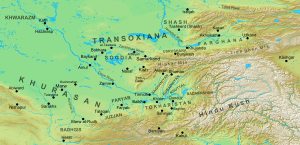Asad ibn Abdallah al-Qasri
Appointed for a second time to govern Khurasan in late 734, Asad brought fresh troops into the province and managed to suppress Harith's uprising in 735–736, although the rebel leader himself escaped capture.Despite Asad's death a few months later, this success was instrumental in preserving Muslim rule in Central Asia, as the blow to the qaghan's prestige led to his murder soon after and the collapse of Türgesh power.[1][2] In 724, immediately after Hisham ibn Abd al-Malik (r. 724–743) ascended the throne, Asad's brother Khalid al-Qasri was appointed to the important post of governor of Iraq, with responsibility over the entire Islamic East, which he held until 738.[7] Thus in 107 AH (725 or 726 AD) Asad campaigned against Namrun, King of al-Gharshistan (northeast of Herat), whom he forced to submit and convert to Islam, before going on to subdue the region of Ghur (central Afghanistan).[9] In either case, Asad's military ventures were only moderately successful, and most importantly failed to address the growing danger of the Türgesh, who with the support of the local princes threatened to expel the Arabs back beyond the Oxus.This measure was vehemently opposed by the Arab settlers of Khurasan, but according to Khalid Yahya Blankinship "it may have helped to discourage the Turks for a couple of years by keeping the Transoxianans on the Muslims' side".[14] Asad was dismissed from his office in Ramadan 109 AH (December 727 or January 728 AD), when in an outburst of anger he had the chief representatives of the four greatest Arab tribes in Khurasan, the Ahl al-Aliyah, Azd, Tamim, and Bakr, publicly flogged.The new governor at first continued Asad's policy of conciliation, but then reversed it, leading to the outbreak of a full-scale rebellion in Transoxiana, which, coupled with renewed Türgesh attacks, reduced the Arab presence there to Samarkand and its environs.[20][21] Ashras was able to recover Bukhara, but his successor, Junayd ibn Abd al-Rahman al-Murri, presided over the disaster of the Battle of the Defile, which crippled the Khurasani army, in 731.[24][25][26] Asim's position remained precarious, however, and he wrote to the Caliph, asking for the placement of Khurasan once again under the purview of Iraq, the appointment of a new governor and the substantial reinforcement of the province with Syrian troops.[31][32] Asad divided his forces, sending the Kufan and Syrian troops under Abd al-Rahman ibn Na'yum towards Marw Rudh, where Harith's main army was located, while he himself with the Basrans and remaining Khurasanis marched on the fortresses of Amul and Zamm.This decision was influenced by several factors: Balkh was the traditional, pre-Islamic capital of Khurasan, and remained so in the eyes of the local population; it lay closer to Tokharistan, where Asad concentrated his military activities; and it was settled by reliable Syrians, removed from the factional politics of the Khurasani Arabs of Marw.[42][43][44] After his victory over the Türgesh, Asad sent an expedition against Badr Tarkhan, possibly a prince of Bamiyan in Ghur, who had taken advantage of the turmoil of the previous year and captured Khuttal.Even though as yet "practically confined to the ruling classes" and limited to the territories under direct Arab control, Gibb credits Asad with beginning a process of "true reconciliation".[50] His successor, Nasr ibn Sayyar, was able to build upon Asad's work and restore the Arab position over much of Transoxiana; Muslim pre-eminence over western Central Asia was sealed with the Battle of Talas in 751, and the withdrawal of Chinese influence after the outbreak of the An Lushan Rebellion.
UmayyadKhurasanTürgeshal-Harith ibn SurayjArabicUmayyad CaliphateHisham ibn Abd al-MalikKhalid al-Qasrigovernor of IraqDay of ThirstTransoxianaSoghdiansmawaliBattle of the DefileKhuttalqaghaninitial Arab setbacksBattle of KharistanCentral AsiaIslamizationBajilaIslamic prophetMuhammadMuhammad's companionsUmayyadsFirst FitnaIbn al-ZubayrSecond FitnaAbd al-MalikPatricia CroneMuslim ibn Sa'id al-KilabiFerghanaSoghdianH. A. R. Gibbal-GharshistanAfghanistanTokharistanKhalid Yahya BlankinshipdihqanShi'iteAbbasidHashimiyyaSaman KhudaSamanid dynastydirhamQutayba ibn MuslimChinese courtNishapurTahiridRamadanal-Hakam ibn Awana al-KalbiSamarkandBukharaJunayd ibn Abd al-Rahman al-MurriSyrianMuslim conquestof TransoxianaRabi b. ZiyadUbayd Allah b. ZiyadSa'id b. UthmanSalm b. ZiyadQutayba b. MuslimQasr al-BahiliBaykandKamarjaThe DefileThe BaggageKharistanRevolt of al-Harith b. SurayjReconquests of Nasr b. SayyarGardizitribal rivalriesYamaniMudariRabi'ahMarw RudhBasransTirmidhBadakhshanamnestyJuday al-Kirmanial-Tabariattacked and almost annihilatedJuzjanHephthaliteBamiyanNasr ibn SayyarBarmakNarshakhiBattle of TalasAn Lushan RebellionBlankinship, Khalid YahyaCrone, PatriciaFrye, R. N.Frye, Richard N.Cambridge University PressGibb, H. A. R.The Royal Asiatic SocietyKramers, J. H.Lévi-Provençal, E.Schacht, J.Lewis, B.Pellat, Ch.Hawting, G. R.Ménage, V. L.
